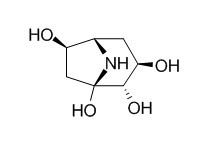Calystegine B1
Calystegine B1 is a noncompetitive inhibitor of rice alpha-glucosidase, with a Ki value of 0.9 +/- 0.1 microM. Calystegine B1 and Calystegine C1 are potent competitive inhibitors of the bovine, human, and rat beta-glucosidase activities, with Ki values of 150, 10, and 1.9 microM.
Inquire / Order:
manager@chemfaces.com
Technical Inquiries:
service@chemfaces.com
Tel:
+86-27-84237783
Fax:
+86-27-84254680
Address:
1 Building, No. 83, CheCheng Rd., Wuhan Economic and Technological Development Zone, Wuhan, Hubei 430056, PRC
Providing storage is as stated on the product vial and the vial is kept tightly sealed, the product can be stored for up to
24 months(2-8C).
Wherever possible, you should prepare and use solutions on the same day. However, if you need to make up stock solutions in advance, we recommend that you store the solution as aliquots in tightly sealed vials at -20C. Generally, these will be useable for up to two weeks. Before use, and prior to opening the vial we recommend that you allow your product to equilibrate to room temperature for at least 1 hour.
Need more advice on solubility, usage and handling? Please email to: service@chemfaces.com
The packaging of the product may have turned upside down during transportation, resulting in the natural compounds adhering to the neck or cap of the vial. take the vial out of its packaging and gently shake to let the compounds fall to the bottom of the vial. for liquid products, centrifuge at 200-500 RPM to gather the liquid at the bottom of the vial. try to avoid loss or contamination during handling.
Plant Biotechnol (Tokyo).2024, 41(3):267-276.
Evidence-based Compl.&Alternative Med.2023, 5417813
Plant Physiol Biochem.2021, 160:166-174.
Int. J. of Food Properties2017, S108-S118
Molecules.2023, 28(8):3474.
Biomedicines.2024, 12(12):2928.
Medicina (Kaunas).2020, 56(12):685.
Antioxidants (Basel).2020, 9(11):1121.
Pharmacogn Mag.2015, 11:S585-91
Pharmaceutics.2021, 13(11):1839.
Related and Featured Products
Carbohydr Res. 1997 Nov 10;304(2):173-8.
Enzymatic synthesis of the glycosides of calystegines B1 and B2 and their glycosidase inhibitory activities.[Pubmed:
9449768]
Several glycosides of Calystegine B1 and calystegine B2 were synthesized by use of rice alpha-glucosidase and the whole cells of Rhodotorula lactosa, and their glycosidase inhibitory activities were investigated.
METHODS AND RESULTS:
Incubation of mixture of Calystegine B1 and maltose with rice alpha-glucosidase gave 3-O-alpha-D-glucopyranosylCalystegine B1 (2, 11.3%). An enzymatic beta-transglucosylation reaction of Calystegine B1 or calystegine B2 with cellobiose using the whole cells of R. lactosa gave 3-O-beta-D-glucopyranosylCalystegine B1 (1) (0.9%) or 4-O-beta-D-glucopyranosylcalystegine B2 (3, 11.2%), respectively, while similar beta-transgalactosylation of calystegine B2 from lactose gave 4-O-beta-D-galactopyranosylcalystegine B2 (4, 10.1%).
CONCLUSIONS:
The glycosylation of Calystegine B1 and calystegine B2 markedly decreased or abolished their inhibition against beta-glucosidase, alpha- or beta-galactosidase.
Glycobiology. 1997 Dec;7(8):1085-8.
The effects of calystegines isolated from edible fruits and vegetables on mammalian liver glycosidases.[Pubmed:
9455909]
The polyhydroxylated nortropane alkaloids called calystegines occur in many plants of the Convolvulaceae, Solanaceae, and Moraceae families. Certain of these alkaloids exhibit potent inhibitory activities against glycosidases and the recently demonstrated occurrence of calystegines in the leaves, skins, and sprouts of potatoes (Solanum tuberosum), and in the leaves of the eggplant (S. melongena), has raised concerns regarding the safety of these vegetables in the human diet.
METHODS AND RESULTS:
We have surveyed the occurrence of calystegines in edible fruits and vegetables of the families Convolvulaceae, Solanaceae, and Moraceae by GC-MS. Calystegines A3, Calystegine B1, Calystegine B2, and Calystegine C1 were detected in all the edible fruits and vegetables tested; sweet and chili peppers, potatoes, eggplants, tomatoes, Physalis fruits, sweet potatoes, and mulberries. Calystegine B1 and Calystegine C1 were potent competitive inhibitors of the bovine, human, and rat beta-glucosidase activities, with Ki values of 150, 10, and 1.9 microM, respectively for B1 and 15, 1.5, and 1 microM, respectively, for C1. Calystegine B2 was a strong competitive inhibitor of the alpha-galactosidase activity in all the livers.
CONCLUSIONS:
Human beta-xylosidase was inhibited by all four nortropanes, with calystegine C1 having a Ki of 0.13 microM. Calystegine A3 and Calystegine B2 selectively inhibited the rat liver beta-glucosidase activity. The potent inhibition of mammalian beta-glucosidase and alpha-galactosidase activities in vitro raises the possibility of toxicity in humans consuming large amounts of plants that contain these compounds.



